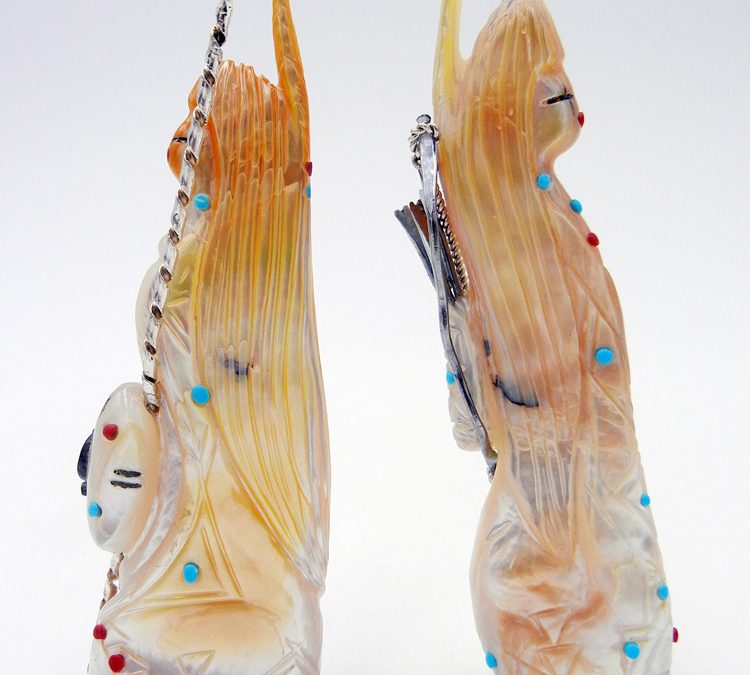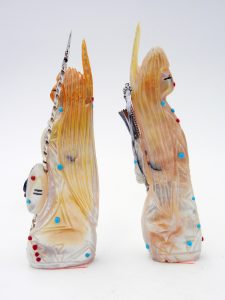When it comes to Zuni fetishes, “more than meets the eye” only begins to scratch the surface of all that lies behind these beautiful Native American carvings. In fact, the stories and history behind fetishes extend far beyond what many view as just a stone carving of an animal, encompassing spiritual and religious focuses that have spanned several centuries. Here, we would like to help educate you on the true meaning behind these lovely works of art that are, as you will see, much more complex and full of legend and history than you could have imagined.
Zuni people have long carried “charm stones,” believed to bring good fortune, power or protection, also known as fetishes. The most simplistic and natural of these that look like animals, or even humans, are known as “concretion” 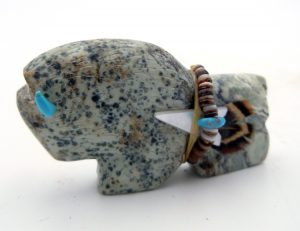 fetishes, or “Alashiwe” (meaning “stone ancients”) which require very little carving to bring out an image and are considered more powerful than fetishes that require a great deal of carving. One legend within Zuni mythology explaining this belief can be found in Kent McManis’ book Zuni Fetishes and Carvings, excerpted here:
fetishes, or “Alashiwe” (meaning “stone ancients”) which require very little carving to bring out an image and are considered more powerful than fetishes that require a great deal of carving. One legend within Zuni mythology explaining this belief can be found in Kent McManis’ book Zuni Fetishes and Carvings, excerpted here:
“The Zunis believe that the world was once covered with floodwaters, which left it swampy. The Sun Father, revered by the Zunis as the giver of life and light, created twin sons. The Twins realized the world was too wet for humankind to survive and needed to be dried. The Sun Father had given his sons a magic shield, a bow (the rainbow) and arrows (lightning). The Twins placed their shield on the earth, crossed the rainbow and lightning arrows on top of it, and shot an arrow into the point where they crossed. Lightning flew out in every direction, creating a tremendous fire. Although this dried the earth, it made it too easy for predators to catch and eat people. So, to save humanity, the Twins struck these animals with their lightning, burning and shriveling them into stone. But deep within, the animals’ hearts were kept alive, with instructions to help humankind with the magic captured in their hearts. When a Zuni find a stone that naturally resembles an animal, he believes that it is one of these ancient stone beasts.”
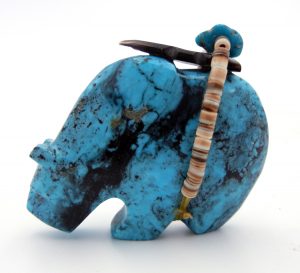 While most Zuni fetishes today look considerably different from the fetishes described in this legend, the inherent beliefs remain. Many Native American traditions recognize a special connection to nature, which includes the integral belief that all things have a spirit. Fetishes, therefore, are believed to have special powers and purposes residing within their spirits, including protection, good health, abundance and fertility, among others.
While most Zuni fetishes today look considerably different from the fetishes described in this legend, the inherent beliefs remain. Many Native American traditions recognize a special connection to nature, which includes the integral belief that all things have a spirit. Fetishes, therefore, are believed to have special powers and purposes residing within their spirits, including protection, good health, abundance and fertility, among others.
There are two major groupings of fetishes: the protective or healing animals, and the hunting or prey animals. Each of the four directions, in addition to the sky and underground, has a protective animal associated with it. The north is protected by the bear, the south by the badger, the east by the wolf, the sky by the eagle, and the underground by the mole. Each direction is also associated with a special color: yellow with the north, blue with the west, red with the south, white with the east, all colors with the sky and black with the underground. When an animal shares its color with its primarily associated direction, that animal is considered the “elder brother” of all like animals. The four directions, sky and underground are also associated with respective hunting or prey animals, with the coyote replacing the bear in the west and the bobcat replacing the badger in the south.
Many fetishes are created with additional features, including the heartline, with represents the breath path leading to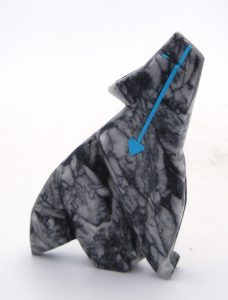 the power in a fetishes’ heart, as well as bundles consisting of various stones, shells and/or arrowheads tied to a fetishes’ back, serving as an offering that empowers the fetish to better aid the user. Fetishes are also said to hold certain and specific powers that can bring desirable outcomes to that fetishes’ owner. Mountain lions are believed to be the most powerful fetishes a hunter can possess when stalking large game. Bear fetishes are said to perform some of the most important healing roles at Zuni. While beliefs concerning owl fetishes differ by tribe, Zunis believe that they are home protectors. For a more detailed and comprehensive list on fetishes and their meanings, please contact us and we will be happy to provide you with more information.
the power in a fetishes’ heart, as well as bundles consisting of various stones, shells and/or arrowheads tied to a fetishes’ back, serving as an offering that empowers the fetish to better aid the user. Fetishes are also said to hold certain and specific powers that can bring desirable outcomes to that fetishes’ owner. Mountain lions are believed to be the most powerful fetishes a hunter can possess when stalking large game. Bear fetishes are said to perform some of the most important healing roles at Zuni. While beliefs concerning owl fetishes differ by tribe, Zunis believe that they are home protectors. For a more detailed and comprehensive list on fetishes and their meanings, please contact us and we will be happy to provide you with more information.
An important thing to remember, as McManis iterates so well, is that “a fetish can represent anything you, as the possessor, want it to represent. It can also have whatever “powers” you so desire. Your strength of belief will likely constitute the most important factor in the efficacy of the fetish.” These wonderful carvings, after all, embody so much more than meets the eye.



